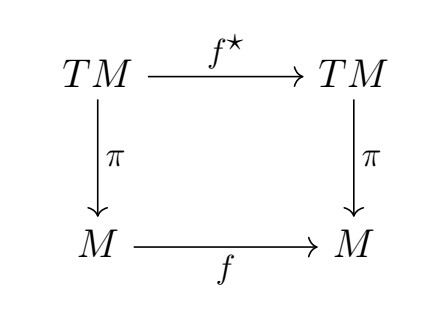Generalised geometry: A study of generalised diffeomorphisms and gauge transformations
We finally arrive at one of the most important properties exhibited by generalised geometry: namely, the manner in how generalised structures preserve a change of to
. As discussed in the previously, this means that we have a pairing of linear transformations that become orthogonal transformations. We also reviewed in a past note about how the Lie algebra of sections of
becomes the Courant algebroid
. But what about diffeomorphisms? From a physical point of view, this is one of the most interesting questions that we can ask; indeed, the study of generalised diffeomorphisms has been an implicit motivation from the outset.
In studying diffeomorphisms in the generalised geometric context, let it be clear that we are interested in diffeomorphisms of that therefore preserve the structure of
. The notion of a generalised diffeomorphism will be entirely analogous to later considerations in the context of double field theory geometry. In principle, and looking ahead, this means that such a map must act on any given fibre as a linear map to another fibre: i.e., underlying this structure is the diffeomorphisms
of the smooth manifold
.
But let’s not get too abstract too soon. The main point for now is that there are a number of approaches to probing the structure of generalised diffeomorphisms and gauge transformations. We shall start with a study of bundle endomorphisms. Considering again the structure group generators in [LINK], equipped with these tools and those analysed throughout the last few notes, we will first look at what transformations in valued algebra leave the inner product invariant and the Courant bracket unchanged.
From endomorphisms to bundle endomorphisms
Recall from a past discussion the study of the generalised vector space
As an initial step, consider the statement that any transformation in leaves the inner product invariant. Consider, for example, a B-shift (Note 3 linked above) with two generalised vectors
. The exponentiation of the antisymmetric transformation (again, see Note 3) can be written as
and we see that
where we use the antisymmetry of the inner product when contracted with the 2-form such that
.
As the whole transformation group leaves the inner product invariant, in order to find the exact subgroup that preserves the general Courant structure we have to look at the transformation of the Courant bracket. It is already somewhat obvious that the Courant bracket is invariant under diffeomorphisms, given it is defined by a coordinate-free expression. But, unlike the Lie bracket, it has an important additional symmetry: it is preserved under B-field transformations, which are B-transforms with the demand that B is closed.
To see this we note that we shall make use of the Cartan identity
which implies . And so we now we want to apply a B-shift to the two sections of the generalised bundle
, take their Courant bracket and substitute the form in eqn. 4 of Note 4.
Proposition 1 (The two-form must be closed) The transformation
is an automorphism of the Courant bracket if and only if
is closed, i.e.
. Let
and
be two sections of
, and define
as a two form. Then
Proof: We begin the proof similar to (1):
where we see that is an automorphism of the Courant bracket if and only if
for all
. Hence, the requirement
.
Courant automorphisms
To understand the symmetries of the Courant bracket, we need to understand its automorphisms. Recall that an automorphism is an isomorphism from a mathematical object to itself preserving all of that object’s structure. The set of all automorphisms of an object forms a group, namely the automorphism group.
An orthogonal Courant automorphism is defined by the pair with
denoting diffeomorphisms of
and
of
such that
represents an orthogonal linear map on each fibre of
. This means that
satisfies
. Combined with the operation of composition, the group of orthogonal Courant automorphisms of
is defined.
Define the diffeomorphism of
, then smooth sections of
transform as
The pair is therefore an orthogonal Courant automorphism. It follows that a subgroup of Courant automorphisms can then be written
But we may also define the subgroup
which now allows us to show that every orthogonal Courant automorphism can be made from a diffeomorphism and a B-field transformation.
Group of generalised diffeomorphisms
As we saw, given the Courant bracket possesses an additional symmetry when compared with the standard Lie bracket – namely, invariance under B-field transformations – an important observation can now be made. The full group that simultaneously preserves the Courant bracket and the inner product is the group of diffeomorphisms on the manifold that we may denote as
.
Theorem 2 (Group of generalised diffeomorphisms) Courant automorphisms, which preserve all of the structure of the generalised tangent bundle
where , are a composition of diffeomorphisms and B-field transformations. The generalised diffeomorphism group is
denotes the set of closed 2-form fields on
. It can also be proven that this is the only group that preserves this structure.
Proof: For covering
, consider the map
, where
is defined below in (13). Since
covers the identity (by definition), we may apply the Leibniz rule for
= G([X,Y]),
to obtain the projection . This means that
necessarily has the form
By orthogonality we obtain
such that
. Thus
, and from before it also follows
must be closed.
Any generalised diffeomorphism can be written as where
and
.
For we have semi-direct product structure of the form
where the action on
is by pullback.
Several remarks are now in order. When extending the analysis from ordinary geometry, which considers the tangent bundle with the Lie bracket, to generalized geometry, which considers exact Courant algebroids with a Courant bracket, it is clear from what we have reviewed that we are considering an enlarged group of symmetries in which diffeomorphisms are a subgroup.
In the semi-direct product (7) different transformations are therefore encoded. Diffeomorphisms take a point in the manifold and map it to another point. So diffeomorphisms are transformations on the manifold. B-transformations, or B-shifts, are local transformations acting on the fibre elements leaving the point on the manifold fixed. Hence, these transformations are pointwise.
Finally, note that for the case where it is possible to define the
-twisted version of the Courant bracket, where
is the familiar closed three-form. The Courant bracket then takes the form
Under a B-transform this bracket satisfies
Generalised diffeomorphisms
We arrive at the punchline. Let’s now look at the concept of generalised diffeomorphisms from a physics bias, emphasising particularly the structure of the Jacobians.
Consider first the standard case. For any diffeomorphism that is a bundle map, the transformation induces a diffeomorphism
. This is true if we replace
with any vector bundle.
For the standard case where the group of diffeomorphisms are bundle maps, the action is linear and satisfies
such that we have exactly the differentials of diffeomorphisms
. Proof of this statement is fairly straightforward. For the conventional Lie bracket invariance under a pushforward can be represented by a commutative diagram

with a diffeomorphism and
the pushforward on the tangent space to
at the point
. As
is a diffeomorphism it follows
acts on a vector field such that
.
The commutative diagram states that the Lie bracket commutes with the pushforward action that is precisely the statement (10).
We now want to extend this analysis to the generalised case.
Definition 3 (Generalised diffeomorphisms) A generalised diffeomorphism
for all is a bundle map that preserves the pairing and satisfies
.
This means that for a diffeomorphisms , with
the Jacobian and
its inverse, the orthogonal bundle map
is an example of a generalised diffeomorphism.
As a brief remark, note that we define the pullback of a form field as , and so we may also define the map
as
. Now we may observe that the Courant bracket commutes in direct analogy of the Lie derivative. So in (12) we have
.
The following commutation diagram describes the generalised case:

Crossing the bridge to physics
We have reached the point in our review of generalised geometry that we can now cross the bridge and think about physics. As we have discussed through the course of several notes, in generalised geometry the geometric objects defined on a tangent bundle (or cotangent bundle) of a manifold are instead defined on the generalised bundle . This geometry, we will see, has proven to have a very close relationship with the geometry of string theory, especially through the 2-form b-field and the workings of T-duality, but also Dp-branes, topological strings, and the study of flux compactifications. This geometry naturally accommodates
, an indefinite metric of signature
, a positive-definite metric that combines
and
, among other notable results.
In particular, we will realise this connection through what is known as double field theory. The doubled geometry of double field theory is also motivated by a fundamental duality of string theory (T-duality), but it starts from the idea that the dimensionality of the manifold itself should be doubled (as we’ll discuss, this comes from the use of doubled coordinates ). Although many questions remain about the nature of doubled geometry, in a few of the well-known approaches and proposals the resulting space is assumed to have an indefinite metric, again of signature
, which breaks the expected
structure to the T-duality group
. In many ways, we will see why there is good argument for how double field theory geometry extends beyond generalised geometry in the sense that it includes generalised geometry, which is to say it is more general. What that means, precisely and with sound definition, is a topic of ongoing research. We will discuss some of the leading hypotheses.
An important focus moving forward, as we transition to a series of notes on double field theory and its geometry, will concern in what ways the notion of generalised diffeomorphisms relates with the physics of doubled diffeomorphisms. In particular, we will take all of the insights extracted from a review of the essential structures of generalised geometry and apply them to a study of doubled geometry – that is, the geometry of manifestly T-duality invariant string theory. One of the very first observations we will make will prove very neat: the NS-NS supergravity fields and
transform under diffeomorphisms and two-form abelian gauge transformation such that, when combined, the field content will be written precisely to ensure
invariance. This is the exact same sort of structure we have already been discussing. Indeed, the usual gauge transformations of the metric
and b-field
will be lifted to
-covariant gauge transformations of the generalised metric
(an object we naturally introduced in a past note) and the dilaton
. In connecting with the physics of string theory, we will also see how the Courant bracket and many other generalised objects appear. Toward the end, we will then discuss another open research topic concerning doubled geometry on the string worldsheet.
In the very least, this is a loose sketch of some of what is to come.


You must be logged in to post a comment.